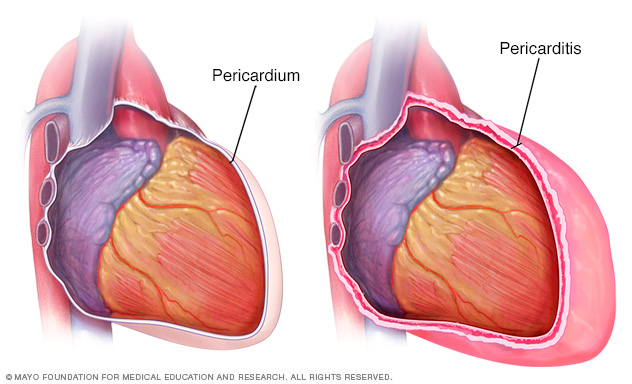Dressler syndrome is inflammation of the sac surrounding the heart (pericarditis). It's believed to occur as the result of the immune system responding to damage to heart tissue or damage to the sac around the heart (pericardium). The damage can result from a heart attack, surgery or traumatic injury. Symptoms include chest pain, which can feel like chest pain from a heart attack.
Dressler syndrome may also be called post-myocardial infarction syndrome, post-traumatic pericarditis, post-cardiac injury syndrome and post-pericardiotomy syndrome.

The heart on the left shows the typical outer lining of the heart (pericardium). The heart on the right shows a swollen and infected lining (pericarditis).
Symptoms
Symptoms are likely to appear weeks to months after a heart attack, surgery or injury to the chest. Symptoms might include:
- Chest pain
- Fever
When to see a doctor
Seek emergency care for sudden or persistent chest pain, which may signal a heart attack or other serious disorder.
Causes
Experts think Dressler syndrome is caused by the immune system's response to heart damage. The body reacts to the injured tissue by sending immune cells and proteins (antibodies) to clean up and repair the affected area. Sometimes this response causes inflammation in the pericardium.
Dressler syndrome may occur after certain heart surgeries or procedures.
Complications
The immune system reaction that causes Dressler syndrome might also lead to fluid buildup in the tissues surrounding the lungs (pleural effusion).
Rarely, Dressler syndrome can cause more-serious complications, including:
- Cardiac tamponade. Inflammation of the pericardium can cause fluid to build up in the sac (pericardial effusion). The fluid can put pressure on the heart, forcing it to work harder and reducing its ability to pump blood efficiently.
- Constrictive pericarditis. Recurring or chronic inflammation can cause the pericardium to become thick or scarred. The scarring can reduce the heart's ability to pump blood.
Prevention
Some studies suggest that taking the anti-inflammatory medication colchicine (Colcrys, Gloperba, Mitgare) before heart surgery might help prevent Dressler syndrome.
Diagnosis
A health care provider does a thorough physical examination, including listening to the heart with a stethoscope. A sound called a pericardial rub can occur when the pericardium is inflamed or when fluid has collected around the heart.
Tests that can help diagnose Dressler syndrome include:
- Complete blood count. Most people with Dressler syndrome have an increased white blood cell count.
- Blood tests to measure inflammation. An increased level of C-reactive protein and an increased erythrocyte sedimentation rate (sed rate) can indicate inflammation that's consistent with Dressler syndrome.
- Electrocardiogram (ECG or EKG). This painless, quick test records electrical signals in the heart through wires attached to the skin. Certain changes in the electrical signals can indicate pressure on the heart. But these changes can exist after heart surgery, so the results of other tests are needed to diagnose Dressler syndrome.
- Chest X-ray. A chest X-ray can help detect fluid around the heart or lungs. It can also help rule out other causes for the fluid, such as pneumonia.
- Echocardiogram. Sound waves produce an image of the heart, which can show if fluid is collecting around it.
- Cardiac MRI. This test uses sound waves to create still or moving pictures of how blood flows through the heart. This test can show thickening of the pericardium.
Treatment
The goals of treatment for Dressler syndrome are to manage pain and reduce inflammation. Treatment may involve medications and, if complications occur, surgery.
Medications
The main treatment for Dressler syndrome is medication to reduce inflammation, including nonsteroidal anti-inflammatory drugs (NSAIDs) such as:
- Aspirin
- Ibuprofen (Advil, Motrin IB, others)
- Colchicine (Colcrys, Gloperba, Mitgare)
If Dressler syndrome occurs after a heart attack, usually aspirin is preferred over other NSAIDs.
Indomethacin also may be given.
If those medications don't help, the next step might be corticosteroids. These powerful immune system suppressants can reduce inflammation related to Dressler syndrome.
Corticosteroids can have serious side effects and might interfere with the healing of damaged heart tissue after a heart attack or surgery. For those reasons, corticosteroids are generally used only when other treatments don't work.
Treating complications
Complications of Dressler syndrome can require more-invasive treatments, including:
- Draining excess fluids. For cardiac tamponade, treatment might be a procedure (pericardiocentesis) in which a needle or small tube (catheter) is used to remove the excess fluid. The procedure is usually done using a local anesthetic.
- Removing the pericardium. For constrictive pericarditis, treatment might involve surgery to remove the pericardium (pericardiectomy).
Preparing for an appointment
If you're being seen in the emergency room for chest pain, you might be asked:
- When did your symptoms begin?
- How bad is your chest pain on a scale of 1 to 10?
- Does anything worsen symptoms? For example, does it hurt more when you take a deep breath?
- Where is the pain? Does it go anywhere beyond your chest?
- Have you recently had a heart attack, heart surgery or blunt trauma to your chest?
- Do you have a history of heart disease?
- What medications do you take?
Copyright © 1998-2025 Mayo Foundation for Medical Education and Research (MFMER). All rights reserved.